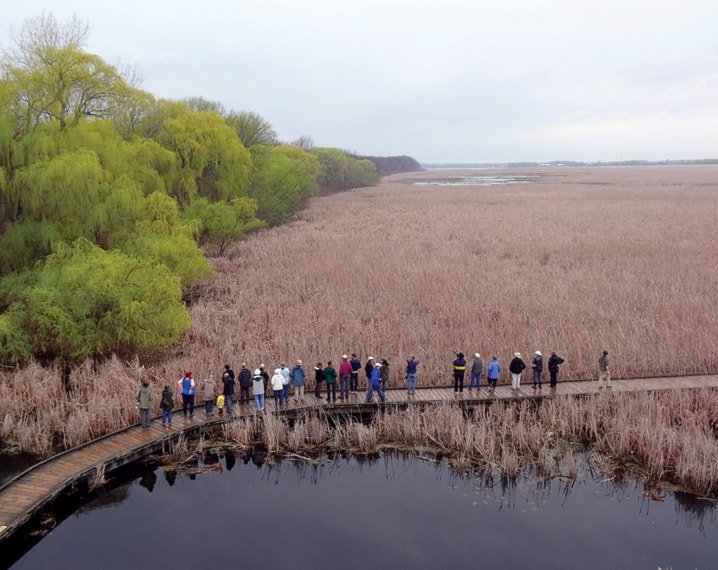I thought I was a birder until I went to Point Pelee National Park in Ontario. There, I realized I was like a runner with her first sneakers doing a lap with Olympic marathoners.
Point Pelee is ground zero for bird watchers.
This 14.5-km finger of land pokes into Lake Erie, its name coming from the French who described it as a bald point. It is the first piece of land that birds migrating north see as dawn breaks over the Great Lakes.
Exhausted, these birds — warblers, orioles, thrushes and flycatchers — drop from the sky to recover. Looking as dazed as human travellers after an all-night trip, these birds can sometimes be seen walking the pathways, surprisingly close to people. As we watched, a small black-and-white warbler allowed photographers to approach within metres. Our guide, Jeremy Bensette, explained, “The birds don’t even have enough energy to avoid people.”
It is the chance to see a large variety of bird species that has ‘twitchers’ — serious birdwatchers — and ‘listers’ — people searching for new species to add to their bird life list — heading to Point Pelee each spring.
Parks Canada and Friends of Point Pelee organize the 19-day Festival of Birds each May.
It includes tours, exhibits and talks on everything from birding by ear to seeing birds on vacation.
This year, David Sibley, creator of a popular birding guide, appeared to rock star-like adulation from a bunch of middle-aged, khaki-clad nature lovers.
I realized this was one vacation where fashion took a backseat to gear.
An outdoor retailer could have shot a commercial here as most people sported the latest outdoor gear, usually in earth tones or camouflage colours.
Hanging off the khaki shirts and Gore-Tex jackets were enough cameras, binoculars and spotting scopes to pay off the debt of a small African nation. I was pleased to see the younger generation participating when a fellow birder approached with a baby stroller. As he got closer, I realized he had twins — cameras, not children — and was using wheels to lighten his load!
The serious birders around me were monitoring their phones for rare bird notifications and would careen across the park to see a rarity. I had just parked at the marsh boardwalk when vehicles started screeching into the parking lot. Doors were flung open and people were hurrying — as fast as one can hurry with a bad knee and several kilograms of gear — towards the marsh.
“It’s a scissor-tailed flycatcher,” yelled one birder, pointing at a tree 500 metre away. “It’s the sighting of the festival,” someone else crowed.
Fortunately, park rangers here carry binoculars as well as guns and understood the viewing frenzy. They calmly directed traffic so everyone got a look at the bird without having to call their insurance agent.
Unlike other festivals, the excitement in Point Pelee is over early each day. By evening, birders migrate to local restaurants for a perch dinner or to wander the streets of Canada’s tomato capital, Leamington.
Eyes turn to the base reflectivity radar showing the birds migrating across Lake Erie.
I felt like a kid on Christmas Eve as I started checking the radar every evening; the growing orange and yellow blobs meant the birds were on the way!
I set my alarm for 4:30 a.m. — an ungodly hour for most tourists — so I could make the park gate opening at 5 a.m. and nab a parking spot.
The shuttle bus that runs visitors to the Point Pelee spit does not start until 6 a.m.
Not wanting to miss the first birds, I walked the 2.9 km from the parking lot to land’s end. The other birders who joined me on the sprint to the spit enjoyed the cacophony of birdcalls and songs as the forest came to life.
A male turkey jogged parallel to us through the trees, storming onto the road every few minutes to display his breeding plumage. I was impressed — the hens less so.
Leaving the turkeys behind, we headed to the beach where the sun was rising over Lake Erie. Red-breasted mergansers chased herring across the mirror-like water.
No birds were staggering along the beach, but plenty had found the trees and bushes.
It was like Christmas morning for adults. We had no idea what birds would be found, but almost any species was possible.
With little effort, we found a black-throated blue warbler, a scarlet tanager and an indigo bunting. The bright blues, red and orange are colours I had always associated with tropical forests; now I was seeing them on Canadian soil.
And I understood why people came from all over the world to participate in a ritual — human and bird — that seems strange at first but makes perfect sense when face-to-face with a bird the colour of a flying orange and a sunrise backdrop to match.
Carol Patterson helps businesses and people reinvent themselves through adventure. When she isn’t travelling for work, Carol is travelling for fun. More of her adventures can be found at www.carolpatterson.ca.
